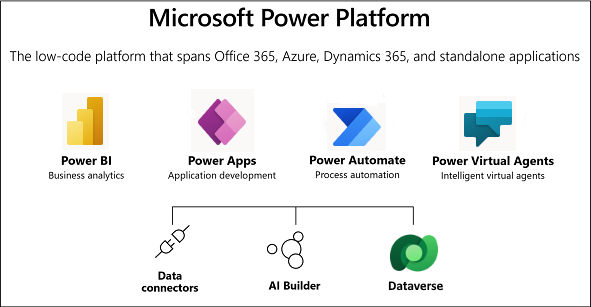Organizations encounter a variety of problems in the ever-changing business world that can stymie their growth and success. Businesses are continuously looking for solutions to stay ahead of the curve, from segregated data and inefficient operations to the requirement for rapid innovation.
Some of the most common challenges include:
- Siloed Data: Data is often scattered across different departments and systems, making it difficult to access, analyse, and utilize effectively.
- Inefficient Workflows: Manual processes and outdated workflows can lead to delays, errors, and decreased productivity.
- Limited Agility: The ability to adapt to changing market conditions and customer demands is crucial for businesses to remain competitive.
- Skills Shortage: Finding and retaining qualified IT professionals can be challenging, especially for smaller businesses.
How Power Platform Addresses These Challenges
Power Platform, a suite of low-code development tools, empowers organizations to tackle these challenges and transform their operations. It provides a unified platform for building custom applications, automating workflows, and analysing data, enabling organizations to achieve their goals more effectively.
- Unifying Data: Power Platform seamlessly connects data from various sources, creating a single, unified view of information that is easily accessible and analysable.
- Automating Workflows: Power Automate enables the automation of repetitive tasks and complex workflows, streamlining processes and improving efficiency.
- Enhancing Agility: With Power Platform, organizations can quickly adapt and innovate, building new applications and modifying existing ones at a rapid pace.
- Empowering Business Users: Power Platform's low-code approach empowers business users to create solutions without extensive coding knowledge, reducing reliance on IT resources.

Components of Power Platform
Power Platform comprises four key components that work together to provide a comprehensive solution for organizations:
- Power Apps: A low-code tool for building custom applications without extensive coding knowledge.
- Power Automate: A tool for automating workflows and tasks, streamlining processes and improving efficiency.
- Power BI: A business intelligence tool for analysing data and creating insightful visualizations.
- Common Data Service: A secure data repository that stores and manages data from various sources.
Benefits of Power Platform
Adopting Power Platform offers a plethora of benefits for organizations, including:
- Increased Productivity: Power Platform streamlines workflows, automates tasks, and empowers employees to work more efficiently.
- Improved Decision-Making: Power BI provides data-driven insights that enable organizations to make informed decisions and improve outcomes.
- Enhanced Agility: Power Platform's low-code approach allows organizations to adapt and innovate quickly, staying ahead of the competition.
- Reduced Costs: Power Platform eliminates the need for extensive IT resources, reducing costs and improving ROI.
Summary
Power Platform emerges as a game changer for enterprises, enabling them to more effectively confront modern challenges and achieve their goals. Its single platform, low-code approach, and comprehensive components make it an effective option for organizations of all sizes. By adopting Power Platform, firms can streamline operations, improve decision-making, and drive innovation, setting the road for continuous development and success in the volatile business environment.
We at Clicentrix have more than two decades of experience implementing CRM & business application systems for medium to large (including some of the Fortune 500 customers). We can help you to assess, design, and implement CRM & business application solutions which fits your budget and requirement. Email at connect@clicentrix.com for more information.


